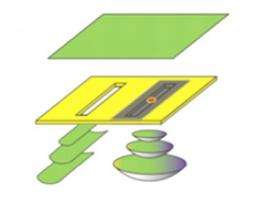January 21, 2011 feature
Which-way detector unlocks some mystery of the double-slit experiment

(PhysOrg.com) -- One of the greatest puzzles of the double-slit experiment – and quantum physics in general – is why electrons seem to act differently when being observed. While electrons traveling through a barrier with two slits create interference patterns when unobserved, these interference patterns disappear when scientists detect which slit each electron travels through. By designing a modified version of the double-slit experiment with a new "which-way" electron detector at one of the slits, a team of scientists from Italy has found a clue as to why electron behavior appears to change when being observed.
As one of the most famous experiments in quantum physics, the double-slit experiment demonstrates how the quantum world is very different from the classical world. When macroscale objects are shot at a barrier with two slits, the objects travel straight through the slits and leave two straight lines on the wall behind the barrier. But when electrons are used instead of macroscale objects, they do not leave two straight lines on the wall but an interference pattern of many lines. Because the interference pattern remains even when the electrons are shot one at a time, the experiment seems to suggest that each electron somehow travels through both slits at the same time and interferes with itself, like a wave instead of a particle.
The second unusual part of the double-slit experiment is that the electrons stop creating an interference pattern when scientists set up a detector near one of the slits to determine which slit(s) an electron is passing through. Under these circumstances, the electrons simply create two straight lines, the same as classical particles.
Throughout the years, scientists have demonstrated different versions of the two-slit experiment. In the new study, physicists Stefano Frabboni from the University of Modena and Reggio Emilia and the CNR-Institute of Nanoscience in Modena, Italy; Gian Carlo Gazzadi from the CNR-Institute of Nanoscience; and Giulio Pozzi from the University of Bologna have presented another version of the two-slit experiment using a transmission electron microscope.
“Over the last few years, we tried to use our expertise in transmission electron microscopy and focused ion beam specimen preparation to realize some basic experiments related to some of the ‘mysteries’ of quantum mechanics, as pointed out by Feynman in his celebrated lectures and books,” Frabboni told PhysOrg.com.
First, the scientists used focused ion beam milling to make two nanoslits on a barrier. Then they modified one of the slits by covering it with a filter made of several layers of “low atomic number” material to create a which-way detector for the electrons passing through.
Although the electrons (which were shot one by one) could still pass through the filtered slit, the filter caused more of the electrons to undergo inelastic scattering rather than elastic scattering. As the physicists explained, an electron undergoing inelastic scattering is localized at the covered slit, and acts like a spherical wave after passing through the slit. In contrast, an electron passing through the unfiltered slit is more likely to undergo elastic scattering, and act like a cylindrical wave after passing through that slit. The spherical wave and cylindrical wave do not have any phase correlation, and so even if an electron passed through both slits, the two different waves that come out cannot create an interference pattern on the wall behind them.
The physicists also found that the thickness of the filter determined the interference effects: the thicker the filter, the greater the probability for inelastic scattering rather than elastic scattering, and so the fewer the interference effects. They could make the filter thick enough so that the interference effects canceled out almost completely.
“When the electron suffers inelastic scattering, it is localized; this means that its wavefunction collapses and after the measurement act, it propagates roughly as a spherical wave from the region of interaction, with no phase relation at all with other elastically or inelastically scattered electrons,” Frabboni said. “The experimental results show electrons through two slits (so two bright lines in the image when elastic and inelastic scattered electrons are collected) with negligible interference effects in the one-slit Fraunhofer diffraction pattern formed with elastic electrons.”
In a separate study, the physicists covered both slits to see if two spherical waves would create an interference pattern. They found that, in the very faint inelastic intensity, no fringes seem present, whereas interference fringes are recovered, at a very low intensity, when the elastic image is taken.
Overall, the results suggest that the type of scattering an electron undergoes determines the mark it leaves on the back wall, and that a detector at one of the slits can change the type of scattering. The physicists concluded that, while elastically scattered electrons can cause an interference pattern, the inelastically scattered electrons do not contribute to the interference process.
More information: Stefano Frabboni, Gian Carlo Gazzadi, and Giulio Pozzi. “Ion and electron beam nanofabrication of the which-way double-slit experiment in a transmission electron microscope.” Applied Physics Letters 97, 263101 (2010). DOI:10.1063/1.3529947
Copyright 2010 PhysOrg.com.
All rights reserved. This material may not be published, broadcast, rewritten or redistributed in whole or part without the express written permission of PhysOrg.com.


















